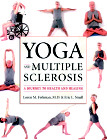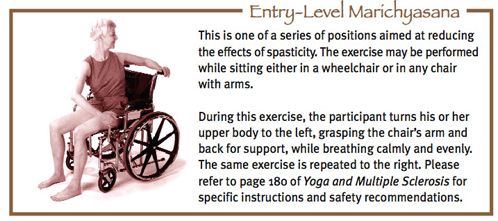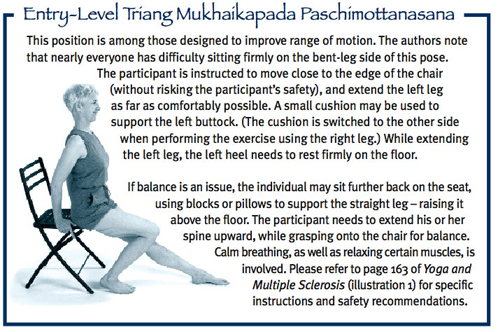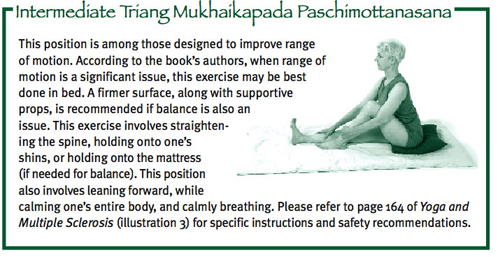Health and Wellness: Enjoying the Benefits of Yoga
Written by Maryann B. Hunsberger
My introduction to yoga came at age 14 when a pen pal sent me the book, Be Young with Yoga, by Richard L. Hittleman. For twenty-one years, I practiced the Hatha yoga poses shown in the book every day. After becoming disabled, I began doing the poses in bed, as the floor was no longer accessible to me. With each exacerbation of my disability and the resultant weight gain, I did less yoga, so I became less flexible and eventually stopped exercising altogether.
The book, Yoga and Multiple Sclerosis: A Journey to Health and Healing (Demos Medical Publishing, 2007) by Loren M. Fishman, MD and Eric L. Small, couldn’t have come across my desk at a better time. After a 126-pound weight loss, I had gingerly resumed exercising, but no longer had my book of yoga postures. I leafed through the pages of Fishman and Small’s book, eager to attempt some basic poses.

Fishman and Small derived the yoga program described in the book from the teachings of B.K.S. Iyengar, one of the world’s most renowned yoga instructors, who practices therapeutic Hatha yoga in Poona, India. Small has spent the past 40 years as an internationally recognized Iyengar yoga instructor. He has also had MS for more than 50 years. He has further developed Iyengar’s work to create a yoga program for MS patients of varying mobility levels. Fishman, an assistant clinical professor in rehabilitation at Columbia University’s College of Physicians and Surgeons in New York City, has incorporated yoga in his medical practice for more than 25 years. Both authors have studied with Iyengar in India.
Hatha yoga is one of several different types of yoga and is the most popular form practiced in the United States. Hatha yoga, through its many postures, strengthens and tones the muscles, enhances flexibility, and increases circulation. Many exercises taught by physical therapists are adaptations of Hatha yoga poses.
People with MS – whether they show no outward signs of illness or whether they use a wheelchair – need physical exercise. Yoga is especially beneficial, as it releases muscular tension, improves flexibility and circulation, helps with balance and fatigue, and boosts mental alertness. It reduces the effect of sensory changes by increasing functional abilities to a higher level.
Yoga is a gentle form of exercise, and the authors point out that yoga always gives more energy than it takes, making it ideal for those whose energy is limited from MS. Since yoga involves sustained muscle stretches, it helps with the spasticity that sometimes accompanies MS by promoting muscle relaxation. Holding these postures requires isometric effort that increases strength. Because yoga encourages muscle groups to work together, it helps with impaired coordination and balance.
According to the authors, individuals with relapsing and progressive types of MS may benefit in seven ways from yoga:
1. Reduction of fatigue
2. Improved range of motion
3. Reduced spasticity
4. Increased strength
5. Improved coordination
6. Improved balance
7. Increased confidence and calmness
The authors divide Yoga and Multiple Sclerosis into two sections: an introduction to gentle yoga poses for people with significant MS involvement, and a functionally oriented segment showing different yoga postures that help specific MS symptoms. Only those who can complete the first part of the book should attempt the second part. Yoga exercise should never hurt, so individuals are advised to only stretch as far as they find comfortable and not exceed the time limits prescribed by the authors for each stretch.

Six series of poses encompass Part I of the book, with pictures showing how to do each pose. Each day’s exercise session begins with the restorative series of poses that promote relaxation. These restful poses take place lying on the floor, but I found lying on the bed easier, with my headboard serving as a wall.
According to the authors, these restorative poses soothe the nervous system and oxygenate the liver, heart, and lungs. The poses, like most postures in the book, require props such as blankets, bolsters, straps, sandbags, blocks, yoga mats, eye bags, and armless chairs. The authors recommend household items – including bathrobe ties, phone books, bath mats, hand towels, and couch pillows – to use in place of standard yoga props.
Wheelchair users can attempt the wheelchair series of poses (with a doctor’s approval). This group of light stretches is intended to strengthen back muscles, tone the legs and arms, lengthen the hamstrings, and increase range of motion. According to the authors, these poses can boost energy by bringing more oxygen into the body, enhancing blood circulation, and stimulating the nervous system. Wheelchair users might need assistance in setting up the props.

This is followed by a series of stationary chair poses, which are performed using an armless folding chair. These stretches improve posture and extend range of motion, while reducing tension in the shoulders and neck. The chair poses also aim to strengthen leg muscles and relieve leg cramps.
Seated poses, which are believed to stimulate elimination and digestion, while improving flexibility, come next. These poses require three folding chairs without arms. Individuals with MS may be able to gain enhanced flexibility in the hips and legs, experience less neck and shoulder tension, and notice reduced lower back discomfort, from doing these postures.
The seated/floor series of postures require the ability to get down to the floor, and in some instances, using a chair as a prop. The authors recommend this series for people who can sit on the floor unassisted. I found most of these poses to be difficult to accomplish, as they require more strength, balance, and coordination than I have. However, strengthened quadriceps muscles, reduced hip-joint stiffness, and reduced spasticity can occur in those who can accomplish these poses.
The relaxation series is comprised of simple poses that are designed to help with the absorption of oxygen. These poses were easiest for me to do on the bed, rather than on the floor. Relaxing the body and quieting the mind is central to these postures, which also assist in reducing stress and tension.

Part II of the book is function directed, so the authors group the poses according to their health benefits. Each section contains three types of poses. Entry-level poses are best for wheelchair users and those in bed. Intermediate postures work best for people with some ambulatory and transferring abilities. Classical poses are suitable for people with the least MS involvement. However, the authors caution that even those individuals with mild disability should start with entry-level poses and work up to classical poses.
Before beginning any exercise program, including yoga, people with MS should consult their physician. If possible, a physical therapist can supervise an individual as he or she learns to do the stretches.
Therapeutic yoga’s most important role is to limit disability, whether the individual has a relapsing-remitting or progressive form of MS. Therefore, patients, physical therapists, and other health professionals can use these poses to address specific MS symptoms, such as limited range of motion, spasticity, reduced strength, and poor coordination. Although yoga cannot cure MS, embarking on a yoga program can improve strength, coordination, and balance. Even those with significantly limited mobility, such as people who are in bed, can gently stretch to strengthen muscles and increase range of motion.
A 100-minute accompanying video, Yoga with Eric Small: Adapted for People with Multiple Sclerosis and Other Disabilities , is available in VHS or DVD form, through the National Multiple Sclerosis Society, Southern California Chapter at (310) 479-4456. The video is appropriate for individuals with all levels of ability and experience.
Practicing yoga may help many people to feel better physically, mentally, and emotionally. As mentioned earlier, before beginning any exercise program, individuals with MS should consult their physician.
About the author of this article
Maryann B. Hunsberger is a New Jersey-based freelance writer/editor who specializes in disability issues. Since 1985, she has written for nonprofit and government organizations, newspapers, magazines, corporations, and internet sites.
About the book, Yoga and Multiple Sclerosis
The information, photos, and captions used in this article were excerpted with permission from Yoga and Multiple Sclerosis: A Journey to Health and Healing. To order online and to view other MS titles, please visit www.demosmedpub.com or call (800) 532-8663.
Other recent publications from Demos Medical Publishing which may be of interest include:
- 101 Accessible Vacations: Travel Ideas for Wheelers and Slow Walkers
- Living with Progressive Multiple Sclerosis: Overcoming the Challenges, 2nd Edition
- Multiple Sclerosis: The Questions You Have – The Answers You Need, 4th Edition
- Complementary and Alternative Medicine and Multiple Sclerosis, 2nd Edition
- Multiple Sclerosis: A Guide for the Newly Diagnosed
Some of these publications, including Yoga and Multiple Sclerosis: A Journey to Health and Healing, may also be borrowed through MSAA’s Lending Library. Please see page 48 for ordering information.
